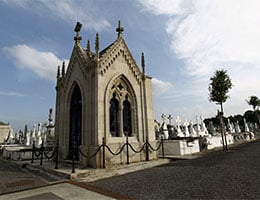 The Latin word funĕbris came into our language as funebre . It is an adjective that is used to refer to that which is linked to the dead .
The Latin word funĕbris came into our language as funebre . It is an adjective that is used to refer to that which is linked to the dead .
A hearse is a vehicle whose main function is to transport dead bodies to the cemetery . It is a car with an elongated chassis in the back of which the coffin (the box containing the body) is placed. The hearse also has the capacity to transport the floral arrangements that are usually placed next to the dead person as a tribute. Along with the driver, on the other hand, one or two companions can travel.
Typically, the hearse transports the coffin from the funeral home (or the place where the farewell ceremony takes place) to the necropolis where the cremation or burial will take place. Sometimes, the hearse is followed by other vehicles that escort it, forming a procession.
A funeral procession , in fact, is a procession that takes place as an accompaniment to the deceased. While the coffin is in the hearse, family and loved ones follow in other vehicles . Funeral processions are especially large when the dead person is a public figure.
The floral arrangement used in this type of ceremony is called a funeral wreath . These circular offerings usually present a sign or inscription with the name of the honoree.
A funeral march , meanwhile, is a musical composition that is created to accompany the progress of the funeral procession. Funeral marches can also be played at the funeral or burial.
 It is known as a funeral or funerary monument, on the other hand, that which is erected in memory of a deceased person, as part of their commemoration . Depending on its size and whether or not it has a space inside, it can be considered funerary architecture . In this context it is necessary to mention the term mausoleum , which in itself serves to denote a very ostentatious funeral monument but also refers to the one built in memory of the king of Caria, Mausolus. This mausoleum is one of the so-called Seven Wonders of the World .
It is known as a funeral or funerary monument, on the other hand, that which is erected in memory of a deceased person, as part of their commemoration . Depending on its size and whether or not it has a space inside, it can be considered funerary architecture . In this context it is necessary to mention the term mausoleum , which in itself serves to denote a very ostentatious funeral monument but also refers to the one built in memory of the king of Caria, Mausolus. This mausoleum is one of the so-called Seven Wonders of the World .
A funeral monument may contain the body of the deceased, and in that case it is also a grave or tomb; Its location usually coincides with the place where it was buried, but this is not a condition since it is often built in a remote place to which the corpse or a part of it is transferred, depending on the manner of death and of its antiquity.
When a funerary monument has more than one tomb inside, it is called a pantheon, although this concept should not be confused with that of a collective tomb , which denotes another type of burial or belongs to different historical and cultural contexts. If the body is not in the monument but it looks like a tomb then it is called a cenotaph . If it is only a construction to remember the person but does not refer to his grave, its most appropriate name is a memorial monument .
In addition to this meaning that relates the term funeral to the deceased, we can also use it to refer to a somber event or one that causes deep sadness. In this case it is an adjective that is not usually part of informal conversations typical of everyday speech but is reserved mainly for texts of a literary or journalistic nature. For example, if we say "the funeral warning" we can express both the announcement of a death and any that anticipates a terrible event.
